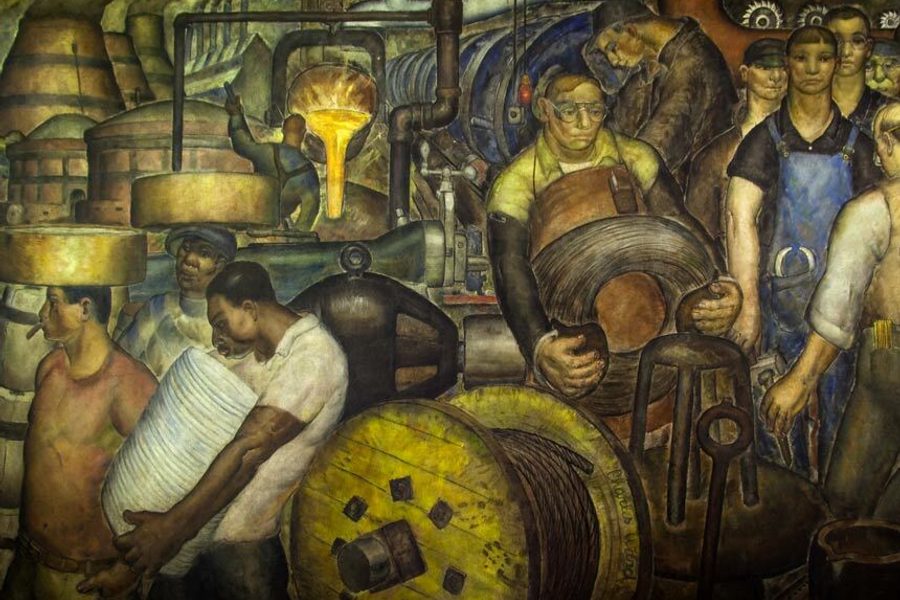The Limits of New Dealism and Why We Need a New Progressive Theory of Political Economy
Historian Jefferson Cowie argues that the New Deal may have been a freak occurrence
Rich Yeselson

In June 1936, Franklin D. Roosevelt gave his second-term acceptance speech to a wildly enthusiastic Philadelphia crowd of 100,000. FDR was at the apex of his popularity; the National Labor Relations Act and Social Security had been signed into law the previous year, and he would go on to win another landslide in November, carrying 46 of the 48 states.
As Vanderbilt historian Jefferson Cowie observes in the opening passage of The Great Exception: The New Deal and the Limits of American Politics, in this stunning speech, FDR came “as close any president has ever come to calling directly for the overthrow of economic interests,” nearly issuing “a declaration of class war.” Roosevelt warned of the dominance of a new class of “economic royalists” or, as he described them at other points during the speech an “industrial dictatorship”; a “new despotism”; and an “economic tyranny.” These tyrants would eliminate American political equality — thus, in order to save our institutions, “they must be overthrown” on behalf of a “war against want and destitution and economic demoralization.”
But just as he reached the podium to begin his speech, supported as always by an assistant and a cane, the cumbersome steel braces supporting his polio stricken legs became unhinged. The president fell to ground. Before others could even notice in the riotous setting, he brusquely ordered his assistants to “clean him up” and get him upright again.
In Cowie’s extended, beautifully wrought metaphor about the limitations of American political culture, Roosevelt’s physical strength lay atop a contingent and frail foundation; so, too, did his political power.
The stadium swelled with cheers, but nobody could realize the New Deal was about to end. By 1938’s midterms, FDR’s bold proposals and schemes — packing the Supreme Court with sympathetic justices, defeating white supremacist Southern Democrats, avoiding another recession — had failed.
The New Deal and the “New Deal order” which sustained it for another 40 years is the “great exception” of the book’s title. While the New Deal and the powerful labor movement that pushed it and partnered with it remain inspirations to liberals and leftists (though they often criticize its shortcomings), they are not an expression of the main currents of American history, but an “extended detour.” Key U.S. “fault lines” — anti-statism, individualism, and cultural, racial, religious and ethnic conflicts — were briefly suppressed during the New Deal and its aftermath, only to return with a vengeance later.
Cowie is neither sentimental about New Deal, in the manner of some liberal scholars decades ago, nor cynically skeptical about its failure to transform or even defeat capitalism at its lowest point ever, as some New Left historian were. He agrees with critics who call the New Deal an incoherent, ad-hoc mess, ungrounded in any overarching theory of political economy.
But he also correctly calls it “the foundation for the greatest age of equality in the United States since the onset of the industrial revolution.” Despite the many limitations of the New Deal that Cowie lists, the American political system, for one unique period, managed to do as much as it did to further collective economic rights. At the same time, he is deeply pessimistic that that system might ever do anything like this again.
In an election year saturated in aspirational politics — with one candidate, Sen. Bernie Sanders, referencing New Deal achievements as examples for today and another, Donald Trump, arguing for a kind of ethno-nationalist welfare statism—The Great Exception is well-timed.
Cowie — like the best work of the mid-century historian Richard Hofstadter, whom he frequently cites — has written not so much a work of American history as a brilliant meditation about a central dilemma of American history. Hofstadter’s first great book, The American Political Tradition and the Men Who Made It, published in 1948, covered all of American political history through diamond-sharp analytical essays about key figures such as Lincoln, John Calhoun and FDR. Hofstadter made the sweeping argument that Americans fought bitterly and sometimes violently over a very narrow ideological turf that almost all shared — one that accepted the tenets of private property and liberal capitalism. Cowie also traverses a wide swath of American political history, from Reconstruction to the first few years of Obama’s presidency, to put forward the thesis that recurrent social and political tendencies of American history sharply define the borders of political possibility.
He thus provides a new variant of “consensus” history: The book’s goal is to rethink, rather than re-narrate, already well-known actors, events and periods, and compel its readers to do the same. In doing so, those readers might wonder whether Cowie has suffocated human agency and historical possibility altogether. In 1959, the American South was an impregnable apartheid sub-nation and young men at American universities amused the nation by stuffing themselves into phone booths. A decade later, the back of Southern apartheid had been broken and college students had found many more important things to do with their time besides squeezing into tight spaces for laughs. So maybe Cowie can’t quite find a way out of the interpretive cul de sac he has constructed, but his trap is worth puzzling over.
In the book’s early chapters, Cowie shows that the militant American working class of the late 19th and early 20th centuries was also the most divided — by race, ethnicity, party affiliation and religion — of any industrializing nation. He notes, “While the [working-class] critiques were lively, they often spoke in different voices.”
Even the early labor movement of Samuel Gompers’s AFL was so deeply suspicious and resentful of the federal courts and federal troops which routinely busted union action that it did not see the benefit or potential of state support for unionism — a support that has, over time, been essential for sustaining the movement. Thus American anti-statism permeated even the country’s most important institutional opposition to organized wealth.
Cowie returns us to the animating conflicts of American workers, divided between blacks and whites, skilled and unskilled, Democrats and Republicans, Catholics and Protestants, native born and immigrants, and regions of the country. The steady growth and power of the corporate form eroded the artisanal “producerist” individualism that skilled white men extolled. This deep skepticism about the state permeated the 19th century labor movement, too, which supported what came to be known as “voluntarism” — a desire for the state to stay out of its affairs — rather than argue for the support of a legal system which consistently blocked collective worker actions. Here again, Cowie is juxtaposing the state activism on the side of workers during the New Deal with the consistent counter-history that came before it.
At every turn in the history of reformist efforts to tame corporate America, these tensions circumscribed possibilities for reform. Social welfare programs prior to the New Deal, were profoundly gendered, with women (and sometimes war veterans) demarcated as a protected, but not an equal, class. The entire Progressive era was marinated in racism, including a significant eugenics movement. Woodrow Wilson partially succeeded in segregating the federal government. The “great commoner” William Jennings Bryan, Wilson’s Secretary of State, supported economic equality only for whites.
The crux of Cowie’s argument is in the chapters on the New Deal’s ambiguous legacy. In what should be understood as a painful irony for every reader who supports a cosmopolitan American Left in the 21st century Cowie argues that the nativist restrictions of the 1924 Immigration Act and the racist exclusion of Southern agrarian and domestic workers from the 1935 National Labor Relations Act actually enabled the white social “cohesion” required for the New Deal. He says that a suspension of immigration provided white workers, at least, with a recipe for class solidarity.
But, underscoring the work of historian Ira Katznelson, Cowie describes how the Roosevelt administration could not create a partial welfare state for white workers via, for example, Social Security, without assuring the Democratic legislators of the apartheid South that the principally black workforces in the agrarian and domestic sectors would be excluded from the law and its benefits.
Cowie sees, too, the paradoxical success of the 1935 National Labor Relations Act (NLRA), passed after an enormous, sometimes violent strike wave in 1934. “For the first and only time in American political history,” the federal government “supported — and even promoted — the right[s]” of workers to unionize. But this triumph also bound labor to a legalistic bureaucracy that dampened the militancy that had compelled Congress and FDR to pass the NLRA in the first place.
Everything had to cohere for the New Deal to happen. Churches and community groups had to be overwhelmed and unable to provide sufficient relief to the destitute of the Depression in order for the anti-statist skepticism of Americans to give way and, instead, look to the state to meet their needs. The Catholic Church’s ambivalence about individualism and suspicion of secular modernity also fitted it well with the collectivist goals of the labor movement; thus, millions of Catholic workers received the implicit and sometimes explicit support of their Church to join unions.
Somehow, Northern blacks saw enough possibility in FDR’s improvisations to start moving from the “party of Lincoln” to the Democratic Party. Yet Southern whites needed to be sufficiently appeased — no anti-lynching bill, no national oversight of their exploitative labor market, plenty of federal funding for projects that would benefit whites like the multi-state Tennessee Valley Authority — that they would remain, for the time being, within the Democratic fold.
A coalition comprised of Southern white Protestants, unionizing Northern white Catholics, Northern blacks, Jewish and other intellectuals was inherently unstable. But that enormous demographic and sociological variation was the key to the success of the Democratic Party of the New Deal era.
The statist imperative to galvanize the entire nation to fight World War II ended the Depression and benefited unions as, for a time, they seemed nearly as essential as corporations to the war effort. The war effort also attached, in one of the most telling phrases in a book full of them, an “illusion of permanence” to the now state-sanctioned power of the labor movement.
Framed by his thesis of the New Deal’s incongruity with the history that came before and after it, Cowie brings some new wrinkles to the familiar story of the New Deal order’s decline. The return of mass immigration in 1965, and especially the great African-American civil rights movement, fracture the partial social solidarity of the white American working class during the period when a strong labor movement seemed to be a permanent feature of the political economy.
Southern whites begin their trek from the “party of the Democracy” to the GOP of Barry Goldwater (who opposed the 1964 Civil Rights Act), Strom Thurmond (who ran for president as a segregationist Dixiecrat in 1948) and Ronald Reagan (who infamously began his campaign for president in 1980 extolling “states’ rights” in Philadelphia, Miss., site of the murder of three civil rights workers in 1964). The cultural, racial and gendered resentments and anxieties that animate the Republican Party of Donald Trump and Ted Cruz are grounded in the return of immigration and the demands for freedom made by black people and women during this period.
Yet even during the Great Society of Lyndon Johnson and the parallel social movements of the 1960s, the ways economic and political reforms took place differed greatly from those of the 1930s and World War II. Cowie argues that the architects of the Great Society took the labor movement for granted and assumed that its role as a kind of private welfare state for one-third of the workforce would remain a permanent feature of American life.
Thus Medicare and Medicaid were limited to those outside the regular workforce — the elderly and the poor. Moreover, as Cowie also notes, the Great Society, rather than seeking to “restructure the economy and redistribute the wealth,” as the New Deal did, instead saw economic problems during the prosperity of the 1960s as requiring the “reform of the individual.” Cowie does not mention the key formulation of the anthropologist, Oscar Lewis, the “culture of poverty,” that proved highly influential later, from the Right to even the socialist writer Michael Harrington.
While praising the great advances brought on by the civil rights and feminist movements, Cowie emphasizes that the “rights discourse” of race and gender did not easily — either culturally or legally — join with the battle for collective economic rights and redistribution that is organized labor’s mission and that was central to the New Deal. Meanwhile, the conservative populism of George Wallace, Nixon’s “silent majority” and Reagan pitted its own version of individualist rights — defending the white workers and small business owners — “against the controlling powers of the state bureaucracy and the courts.” Thus we find ourselves in a situation today in which feminist advocates for “choice” and “gun rights” supporters may have completely different world views, yet both share a language reliant upon individual rights.
The Left and Right versions of individual rights and recognition have been in conflict for over 40 years. Over that period, racist and misogynist bigotry and discrimination have been mitigated, if not ended — white men do not dominate American life quite as much as they did on both sides of the political divide during the 1930s. But wage workers, across gender, ethnicity and race, are more economically vulnerable and less politically powerful than they were during the New Deal’s “working class interregnum.”
As is often the case when historians get to the present, Cowie’s last chapter is its weakest. He seems genuinely ambivalent about assessing president Obama’s record, noting the unconditional opposition of an increasingly reactionary and hyper-partisan Republican Party to his efforts, while also chastising Obama for his “unwillingness to make a bold, decisive break from previous decades and make the case to the American people that the state could help build economic security and opportunity for all.”
He urges today’s liberals and leftists to let go of the New Deal model. But his alternative is frustratingly, if understandably, vague. He urges political activists to look instead to the amorphous and creative ferment of the Progressive Era — cross-class alliances, volunteerism, “enlightened elites” — which, unlike the New Deal (and with the significant and unacceptable exception of its pervasive racism), made the best of “the power of American individualism in American political culture and … sought a bridge between that individualism and a common good.”
Sounds fine. But these variations lack the institutional heft to push the government toward broad economic reforms — something unions once did, though their decline has thrown that power into question. Cowie’s Progressive Era model allows that widely diffuse political goals, from reproductive rights to reforming racist policing, will require appeals beyond citizens’ identities as workers. But where the kind of mass power that unions once exerted will come from is as yet unknown.
The job of a historian, however, is not to predict the future, but to describe a past and its links to the present. Cowie’s book “places the reader in a struggle with the American past.” Cowie admits that this book is grounded in the “muddy tributaries of skepticism fed by Melville rather than walking the sunny fields of Whitman.” Even those readers more instinctively drawn to the greatest bard of American democratic possibility than to his dark and mordant contemporary, owe it to themselves to read the often unsettling, but always stimulating pages of The Great Exception.






